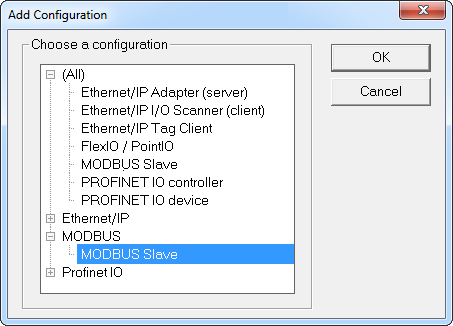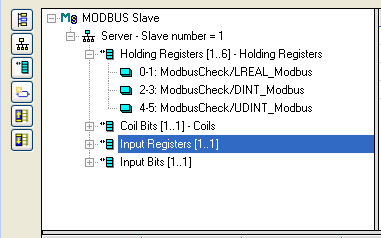Modbus Slave
The KAS Runtime![]() In computer science, runtime (or run-time) describes the operation of a computer program, the duration of its execution, from beginning to termination (compare compile time).
Within KAS, runtime also refers to the virtual machine that manage the program written in a computer language while it is running includes fully integrated slave functions for enabling Modbus
In computer science, runtime (or run-time) describes the operation of a computer program, the duration of its execution, from beginning to termination (compare compile time).
Within KAS, runtime also refers to the virtual machine that manage the program written in a computer language while it is running includes fully integrated slave functions for enabling Modbus![]() ModBus is a serial communications protocol and is now the most commonly available means of connecting industrial electronic devices.
ModBus is often used to connect a supervisory computer with a remote terminal unit in supervisory control and data acquisition (SCADA) systems.
Versions of the ModBus protocol exist for serial port and Ethernet (it is widely used with TCP/IP over Ethernet) communication on a serial link or Ethernet
ModBus is a serial communications protocol and is now the most commonly available means of connecting industrial electronic devices.
ModBus is often used to connect a supervisory computer with a remote terminal unit in supervisory control and data acquisition (SCADA) systems.
Versions of the ModBus protocol exist for serial port and Ethernet (it is widely used with TCP/IP over Ethernet) communication on a serial link or Ethernet![]() Ethernet is a large, diverse family of frame-based computer networking technologies that operate at many speeds for local area networks (LANs).
Ethernet is a large, diverse family of frame-based computer networking technologies that operate at many speeds for local area networks (LANs).
This communication is done in the background, asynchronously, at the cycle time (20-1000 milliseconds) specified in the Controller Properties (see "Configure the Controller").
Variables defined in the HMI![]() "Human-machine interfaces "
Also known as computer-human interfaces (CHI), and formerly known as man-machine interfaces, they are usually employed to communicate with PLCs and other computers, such as entering and monitoring temperatures or pressures for further automated control or emergency response to describe the interface (see Map Variables to HMI) are passed to the AKD PDMM/PCMM this way. This means there is no data coherency in the data exchange because the variables read by the Modbus do not come from the same PLC
"Human-machine interfaces "
Also known as computer-human interfaces (CHI), and formerly known as man-machine interfaces, they are usually employed to communicate with PLCs and other computers, such as entering and monitoring temperatures or pressures for further automated control or emergency response to describe the interface (see Map Variables to HMI) are passed to the AKD PDMM/PCMM this way. This means there is no data coherency in the data exchange because the variables read by the Modbus do not come from the same PLC![]() "Programmable Logic Controller"
A Programmable Logic Controller, PLC, or Programmable Controller is a digital computer used for automation of industrial processes, such as control of machinery on factory assembly lines.
Used to synchronize the flow of inputs from (physical) sensors and events with the flow of outputs to actuators and events cycle. This data has a rather low priority and is interpreted by human feedback and should never be noticed by the user.
"Programmable Logic Controller"
A Programmable Logic Controller, PLC, or Programmable Controller is a digital computer used for automation of industrial processes, such as control of machinery on factory assembly lines.
Used to synchronize the flow of inputs from (physical) sensors and events with the flow of outputs to actuators and events cycle. This data has a rather low priority and is interpreted by human feedback and should never be noticed by the user.
-
-
Kollmorgen HMIs are limited to communicating no more frequently than every 100 milliseconds.
-
-
It is possible to have two Modbus master devices communicating with a controller at the same time, accessing the same variables. An example of this would be having two separate HMI panels running the same program on a single, large machine.
Protocol specification
The protocol supported is Open Modbus on Ethernet. The following Modbus function codes are supported:
| 1 | read coils |
| 2 | read bit inputs |
| 3 | read holding registers |
| 4 | read input registers |
| 5 | write 1 coil |
| 6 | write 1 register |
| 15 | write n coils |
| 16 | write n registers |
As a default, the first valid address for each kind of data is 1. If you use Modbus devices with other addressing conventions, you can change the base offset for each kind of data using the Tools > Addresses menu command.
Data exchange - configuration
A dedicated configuration tool is integrated in the KAS IDE![]() "Integrated development environment"
An integrated development environment is a type of computer software that assists computer programmers in developing software.
IDEs normally consist of a source code editor, a compiler and/or interpreter, build-automation tools, and a debugger. To run it,
"Integrated development environment"
An integrated development environment is a type of computer software that assists computer programmers in developing software.
IDEs normally consist of a source code editor, a compiler and/or interpreter, build-automation tools, and a debugger. To run it,
- Select the Other Modbus devices option in the Controller Properties dialog box. See Configure the Controller for more information.
- Double-click the Fieldbus
 A Fieldbus is an industrial network system for real-time distributed control (e.g. CAN or Profibus). It is a way of connecting instruments in a plant design node in the project explorer to open it
A Fieldbus is an industrial network system for real-time distributed control (e.g. CAN or Profibus). It is a way of connecting instruments in a plant design node in the project explorer to open it - Click the Insert Configuration icon to add the Fieldbus configuration
- Then select the Modbus Slave in the configuration selector

The Modbus Slave configuration is represented as a tree:
- Modbus Slave
- Slave number (variables that can be accessed from external Modbus masters)
- Input bits data block (read by masters)
- Variable (*)
- Input words data block (read by masters)
- Variable (*)
- Coil bits data block (forced by masters)
- Variable (*)
- Holding bits data block (forced by masters)
- Variable (*)
- Input bits data block (read by masters)
(*) The items with this mark can appear several times in the configuration.
- Slave number (variables that can be accessed from external Modbus masters)
Modbus Slave configuration
You need to configure the Modbus Slave in order to make variables visible from external Modbus masters such as SCADA systems. Below is a simple example of slave configuration:
Double click on the Server item to setup the Modbus slave number that will identify the runtime![]() In computer science, runtime (or run-time) describes the operation of a computer program, the duration of its execution, from beginning to termination (compare compile time).
Within KAS, runtime also refers to the virtual machine that manage the program written in a computer language while it is running application. When the local server is selected, use the Insert Slave/Data Block menu command to insert Modbus data blocks. The following kinds of block are available:
In computer science, runtime (or run-time) describes the operation of a computer program, the duration of its execution, from beginning to termination (compare compile time).
Within KAS, runtime also refers to the virtual machine that manage the program written in a computer language while it is running application. When the local server is selected, use the Insert Slave/Data Block menu command to insert Modbus data blocks. The following kinds of block are available:
- Input Bits: bits read by external masters (function 2).
- Coil Bits: bits forced by by external masters (function 5 or 15).
- Input Registers: words read by external masters (function 4).
- Holding Registers: words forced by external masters (function 6 or 16).
-
-
Input Registers require 15-25%less CPU time to exchange data than Holding Registers do. For optimal controller performance use Input Registers where possible.
Each data block is identified by a Modbus base address and a number of items (bits or words).
-
-
Read and write requests sent by Modbus masters will be denied if the range specified in the request does not fit within a data block defined in the configuration. Requests overlapping two data blocks will be denied.
For example, if you configure a block of 16 words starting at address 1 and another block of 16 words starting at address 17, a request for read or write of 32 words starting at address 1 will be denied and an "address error" exception will be reported.
When a server data block is selected, use the ‘New symbol’ command to map a variable to an item of the data block. Each variable is identified by a valid symbol of a variable in the open project and an offset in the data block according to Modbus addressing.
- For exchanging Boolean variables through Modbus words, a hexadecimal mask is available in order to define to which bit of a word a variable is attached. For example, enter the mask "0001" to map a Boolean variable to the less significant bit of a word.
- For exchanging 32 bit variables (DINT, REAL...), you can select to map the variable on two consecutive words.
You can sort the variables of each data block according to their offset using the ‘Sort symbols’ menu command at any time.
Data types
You can freely map a variable of any data type to a Modbus item. The Runtime automatically converts the value to the type of the variable.
- For exchanging Boolean variables through Modbus words, a hexadecimal mask is available in order to define to which bit of a word a variable is attached. For example, enter the mask "0001" to map a Boolean variable to the less significant bit of a word.
- For exchanging 32 bit variables (DINT, REAL...), you can select to map the variable on two consecutive words.
-
-
- 64 bit variable (LINT and LREAL) cannot be extracted directly without lost of accuracy or data.






